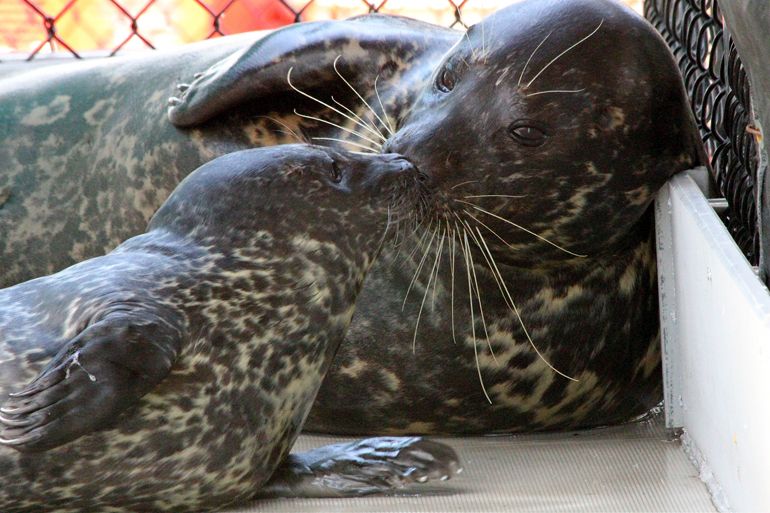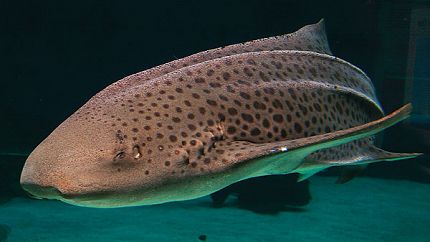Interactions of Phoca vitulina
General Information
Competitive Interactions
Mutualistic Interactions
Predatory Interactions
Parasitic Interactions
Human Uses
For a better understanding of these types of interactions
click here.
General Information
Although the harbor seal is a social mammal, they are solitary
hunters. Touch being their strongest sense, harbor seals rely on the
use of vibrissae (whiskers) to identify prey. They get the majority
of their food in shallow waters but are able to dive deeper if
necessary due to adaptations.
In the food web of life, harbor seals are located right around the
middle region. They are prey to whales, sharks, bald eagles, and
sometimes humans. Below harbor seals are a vast array of fish,
crustaceans, and squid. Harbor seals are opportunistic feeders,
which means that they will eat when and whatever is available (to
some limits). Pacific herring, whiting,
common
shiner,
cod,
rockfish, salmon,
stickleback, haddock, and
perch
are a few examples of fish the harbor seal eats (Luxa et al. 2013
and Howard et al. 2013). Their diet is also composed of mollusks and
shellfish. Harbor seals do not chew their food. Instead, they use
their front teeth
to tear, their back teeth to crush, and then they swallow it whole.
Competitive Interactions
In order to acquire the food sources mentioned above, harbor
seals must engage in competitive interactions.
Dolphins
share the same habitat and similar resources as the harbor seal, so they
must compete in order to survive and produce offspring. A prime
example of a competitive relationship is the interaction between the harbor seal
(Phoca vitulina) and the grey seal (Halichoerus grypus) (Murray,
2008). In the Kattegat-Skagerrak region of Sweden, these two species
compete for resources and territory. Grey seals migrate from the
Baltic Sea to Kattegat-Skagerrak for breeding season, food, and
availability of resources. In a study conducted between harbor seals
and grey seals, there was a higher population growth for harbor
seals in comparison to grey seals (Svennson et al. 2012). This
study, among others, shows that harbor seals are a resilient species
especially when competing against the grey seal. One such method harbor
seals use to ensure population growth is by controlling their
territory. Phoca vitulina are less vocal compared to other
pinnipeds, yet they still exhibit vocalizations including grunts,
growls, and snorts to show territory. Males engage in fighting
and “visual aquatic displaying” to defend breeding grounds and
display dominance (Hanggi and Schusterman, 1992).

Photo Credit: Kera Mathes, © Aquarium of the Pacific
Mutualistic Interactions
Although competing for resources results in successful
acquisition and producting of offspring, a mutualistic interaction
can often do the same thing. A mutualistic relationship benefits both organisms participating.
One example of a mutualistic relationship is the group foraging
tactics used by harbor seals (Perrin et al. 2008). In order to
increase net energy intake, harbor seals will work together to
achieve a common goal. The coordinated effort of herding prey
results in a greater benefit to both or all organisms engaging in
the mutualistic relationship. This cooperative foraging results in
cooperative food sharing between harbor seals. Most commonly, food
sharing occurs between mother and pup, but can occur between
unrelated harbor seals as well. Harbor seals also engage in social
interactions with other seals such as the
harp seal. Socializing includes migrating together, hunting
together, and basic communication. Some of these mutualistic
relationships can be seen as commensal relationships, but commensal
relationships are not commonly seen with the harbor seal.

Mother Shelby interacting with newborn male pup.
Photo Credit: Hugh Ryono, © Aquarium of the Pacific
Predatory Interactions
When harbor seals engage in hunting or foraging behaviors, whether it be through mutualism with others or competion, they also engage in a predatory interaction. As a predator, harbor seals prey on a variety of fish, crustaceans, and mollusks. Diet depends on seasonal variations as well as abundance (Bjorge and Olsen, 1995). Other predatory relationships with the harbor seals as the predator involve the Humboldt Squid and the Pacific Herring (Bromaghin et al. 2013 and Luxa et al. 2013). In one specific situation noted by Tallman and Sullivan, a harbor seal engaged in a predatory relationship with a male harlequin duck. Seabirds are not an observed part of the harbor seal diet, nor of other pinniped diets. After this observation, research was conducted. Prior documentation indicated that although this was the first documentation of a harbor seal-harlequin duck interaction, there was record of predation between other pinniped species and seabirds (Tallman and Sullivan, 2003).
As the
prey, harbor seals are mainly hunted by
orca
whales (Orcinius orca),
great
white sharks (Carcharodon carcharius), and bald eagles (Haliaeetus
leucocephalus). Other predators include subspecies of shark such
as the
bull
shark, sand tiger shark, and zebra shark. The most prominent cases of harbor seal killings via orca
whales occur as pups are being weaned (Lewis, 2005). During this
time period, pups spend less time with the mother. Pups engage in
foraging on their own while weaning. Therefore, they are less
protected by the mother (Gaydos et al. 2005).
Great white sharks and bald eagles are also a major threat to pups
and adult harbor seals alike (Cale, 2012 and Hayward, 2008). Both
species prey on the pups when they are most vulnerable. Pups are smaller
and weaker than adult harbor seals and are often left unattended
during weaning periods. This is when the great white sharks and bald eagles attack.
The sharp teeth and strategizing of the great white shark and razor
sharp talons and strength of the bald eagle are no match for these small pups
(Cale, 2012 and Hayward, 2008).


Bull shark. Photo Credit: © Aquarium of the Pacific
Zebra shark. Photo Credit: © Aquarium of the Pacific

Sand tiger shark. © Aquarium of the Pacific
Parasitic Interactions
Lastly, a harbor seal can participate in a parasitic interaction. A parasitic relationship occurs when one organism lives off
another. The "parasite" benefits while the "host" is often harmed up
to the point of death. Once the parasite attaches itself to the host
(via oral ingestion or external parasitism) it uses up nutrients
from food the harbor seal consumes. The harbor seal unwillingly
serves as a host to a variety of protozoans, viruses, bacteria, and
worms across the globe. Take a look at the
Anisakis simplex for more information.
Apicomplexan protozoans regularly infect wild marine mammals
according to reports over the past 20 years. Harbor seals are most
susceptible to Toxoplasma gondii and Sarcocystis neurona
but can be infected by other protozoans as well (LaPointe et al.
2003).
Phocine Distemper Virus can reduce harbor seal populations by as
much as seventy percent! The intended target organs differ among
parasites and hosts. Other virus infections include Influenza B and
Influenza A. Influenza B virus infections occur in seal populations
and can be a serious issue if circulated back to humans
(Osterhaus et al. 2000). Pneumonia caused by Influenza A virus
infection led to a large scale mortality between 1979 and 1980: over
400 harbor seals died (Geraci et al. 1982).
In 2004, the first report of a giant kidney worm was published.
Harbor seals infected with the kidney worm exhibited severe symptoms
prior to death. Autopsies confirmed these severe symptoms through
tissue analysis (Hoffman et al. 2004). Since 2004, more parasitic
relationships involving nematodes have been identified. Studies
conducted between Cryptosporidium spp. and harbor seals
showed a harbor seal’s ability to host more than one
Cryptosporidium spp.
Unfortunate for the harbor seal, Cryptosporidium is commonly
linked to gastrointestinal disorders (Bass et al. 2012).
Human Uses
A variety of interactions take place between humans and harbor seals. First, harbor seals and humans compete for land and resources. Fisheries compete with the harbor seals for fish and water territory, but this relationships often becomes parasitic. The vast majority of deaths related to fishery incidents are due to harbor seals getting caught in the nets. Although this action is unintentional, harbor seals struggle to be freed and hurt themselves severely in the process (Hall, 1995). Cruise ships are also dangerous for marine mammals. Not only is their size and strength threatening, but their presence disturbs haul-out patterns for harbor seals (Jansen et al. 2010).
Unfortunately, some harbor seal deaths are intentional. "Harbor seals in Baja California have been known to have been killed as bait for shark long line fishing" (Hall, 1995). Harbor seal hunting still occurs in several areas of the world including Greenland, Iceland, Norway, and in Canada by some Inuit tribes (Seal Conservation Society, 2011). Although these numbers are decreasing as culture changes, it is essential that legislation continue to be enforced against excessive harbor seal hunting to prevent this species from ever reaching endangered status. Harbor seals need committed companions (us) to help conserve their habitat and lives. Go to Contact Us for information on conservation.
